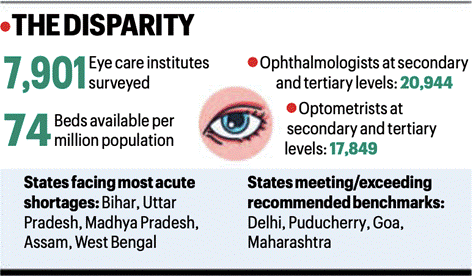Why in News?
- A national survey by AIIMS Delhi (2025) on “Human Resources and Infrastructure for Ophthalmic Services in India” found India has only 15 ophthalmologists per million population — far below WHO’s recommended benchmarks.
- The survey covered 7,901 eye care institutes, highlighting regional disparity, workforce shortages, and infrastructure gaps in eye care services.
Relevance
GS-2 (Social Justice – Health):
- Public health infrastructure gaps; NPCBVI under Vision 2020.
- Human resource deficit in healthcare — shortage and regional imbalance.
- Policy need: Integrating eye care with primary healthcare (Ayushman Bharat–HWCs).
- Importance of telemedicine and digital health networks.
GS-3 (S&T and Economy):
- Strengthening healthcare R&D, medical education, and allied health services.
- Role of AI, tele-ophthalmology, and innovation in public health delivery.

Basic Context
1. What is Ophthalmology?
- Branch of medicine dealing with diagnosis, treatment, and prevention of eye diseases.
- Core to achieving Universal Eye Health and eliminating avoidable blindness.
2. Global Target – Vision 2020: The Right to Sight
- Joint initiative by WHO and International Agency for the Prevention of Blindness (IAPB).
- Aimed to eliminate avoidable blindness by 2020 and ensure equitable access to eye care.
- India adopted the Vision 2020: India program under the National Programme for Control of Blindness and Visual Impairment (NPCBVI).
Key Findings of AIIMS Study (2025)
| Indicator | Data |
| Institutes surveyed | 7,901 |
| Eye care beds per million population | 74 |
| Ophthalmologists (secondary + tertiary levels) | 20,944 |
| Optometrists | 17,849 |
| Average per capita availability | 15 ophthalmologists / million population |
| Target (WHO/AIIMS Vision 2020) | 20–25 ophthalmologists / million |
| States below benchmark | Bihar, Uttar Pradesh, Madhya Pradesh, Assam, West Bengal |
| States meeting/exceeding | Delhi, Puducherry, Goa, Maharashtra |
| Highest variation | From 127 per million (Ladakh) to just 2 per million (Bihar) |
Overview
1. Magnitude of Deficit
- India’s 20,944 ophthalmologists for ~1.4 billion people = severe shortage.
- WHO recommends at least 20 per million → India falls short by ~25–30% nationally, and >70% in BIMARU states.
2. Regional Inequality
- Urban concentration: 70% of ophthalmologists in metro or Tier-1 cities.
- Rural areas: Home to 65% of population but only 20% of eye care facilities.
- States like Bihar and UP show “eye-care deserts”.
3. Infrastructure Deficits
- Only 15.6% public and 18.3% NGO-run institutes, the rest private — leading to affordability and access issues.
- Beds: 74 per million — far below desired 100 per million benchmark.
- Poor integration of primary eye care into general PHC system.
4. Burden of Eye Diseases
- India accounts for ~20% of global blindness burden.
- Major causes: Cataract (~66%), uncorrected refractive errors (~25%), glaucoma, diabetic retinopathy.
- National Blindness Survey 2019: Blindness prevalence = 0.36%, visual impairment = 2.55% — updated AIIMS projections (2025) show little improvement.
Programs & Initiatives
| Program | Key Features |
| NPCBVI (1976, revamped 2017) | Free cataract surgeries, vision screening, eye banks. |
| Ayushman Bharat Health & Wellness Centres | Integration of primary eye care. |
| Digital Health Mission | e-OPD, teleophthalmology in remote areas. |
| District Blindness Control Societies | Local implementation of eye-care schemes. |
| Pradhan Mantri Ayushman Bharat Health Infrastructure Mission (PM-ABHIM) | Strengthens tertiary care, including eye hospitals. |
Challenges
- Shortage of trained ophthalmologists & optometrists in rural belts.
- Skewed distribution — north-central states lagging.
- Infrastructure underutilization due to lack of human resources.
- Limited R&D and training institutes in community ophthalmology.
- Dependence on NGOs like Aravind Eye Care, LV Prasad Eye Institute for outreach work.
Policy Implications
- India needs at least 35,000 ophthalmologists to meet the WHO norm.
- Expand fellowship and residency capacity under NPCBVI.
- Integrate optometrists into public health cadre under National Allied Health Policy (2023).
- Incentivize posting in underserved districts through performance-linked grants.
- Adopt “Hub and Spoke” eye-care networks using telemedicine (AIIMS model).



